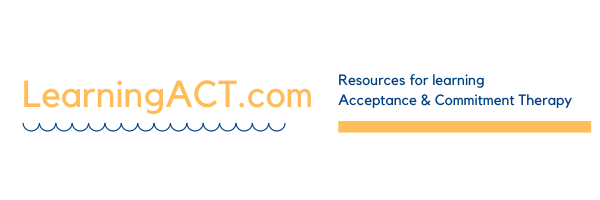 A few years ago a group of ACT trainers got together and used to consensus process to create a set of ACT core competencies. My coauthors and I recently revised these competencies in our book Learning ACT. Over the last couple years, I have found myself using the ACT Core Competency Rating Form at an increasing rate in helping people learn ACT and I thought I’d share some of my experiences with other ACT supervisors. Most of my experience is based on my work in advanced consultation for people who are already licensed, but I do engage in some formal supervision with students.
A few years ago a group of ACT trainers got together and used to consensus process to create a set of ACT core competencies. My coauthors and I recently revised these competencies in our book Learning ACT. Over the last couple years, I have found myself using the ACT Core Competency Rating Form at an increasing rate in helping people learn ACT and I thought I’d share some of my experiences with other ACT supervisors. Most of my experience is based on my work in advanced consultation for people who are already licensed, but I do engage in some formal supervision with students.
The form can be used as either a self or other rating form. One way I use the form is to have the trainee self-rate on their utilization of the various competencies. This is often most useful when the trainee is new to you and you would be unable to evaluate their own use of the competencies. This can serve as a nice baseline of their self assessment of competency and areas for improvement. Repeated self assessment over time can continue to help focus supervision and also help to track change. Another way to use the form is to rate the trainees use of the ACT core competencies, usually only appropriate once you have a fair amount of experience observing their work. Reviewing this with the trainee can serve an important feedback function.
Usually I will review the ratings with the trainee and talk about any patterns that we see. In these reviews, I emphasize that the purpose of the ratings is primarily to assist learning and to help focus the supervision.
In reviewing the ratings I try to look for patterns in the data. One pattern I look for is whether any individual competency items are rated much lower than the other items within a particular process. If this is present, then we discuss the reason for this discrepancy. Commonly a practice exercise that might emerge out of this conversation would be some sort of between-session practice in which thee trainee identifies a client or clients with whom they can use that competency. It can also be helpful to identify the manner or context in which they might use that competency. They might be specifically asked to prepare and study various metaphors or exercises that they might use when implementing the competency. Finally, the trainee implements that competency in as many situations as it is relevant and ethical. The goal is to help them to practice the competency and to produce material to respond to in the next supervision session.
Other patterns to look for are broader, for example when certain processes are more often focused on than others. Perhaps the trainee tends to focus heavily on values and commitment but rarely works on contact with the present moment. Looking at these broader patterns can suggest longer term areas of focus for the supervision and perhaps help trainee and supervisor prioritize areas of skill-building in their learning of ACT. This might take the form of additional readings, practice role plays (with both supervisor or trainee as therapist), or experiential work, depending upon the barriers to utilization of the competency.
Keep in mind when using the form, that it can be filled out using various time frames, depending upon what you are wanting to assess. The form could be used to rate a single session, the past month, or even how they are in general. Each of these can serve specific training functions.
I’d be interested in anyone’s comments or ideas on this post. You can either reply right here, or in the Learning ACT Forum . Either would be welcome!
BTW, there are additional ideas on supervision/consultation in the appendix of the Learning ACT book, if you are wanting more to read on that subject.
